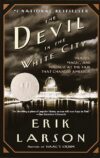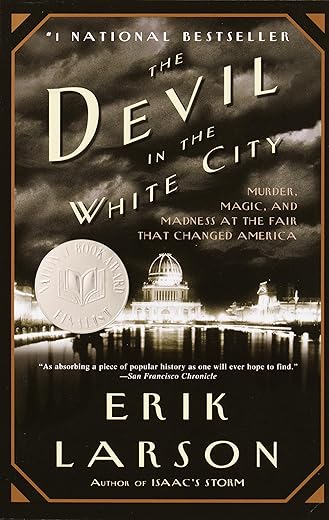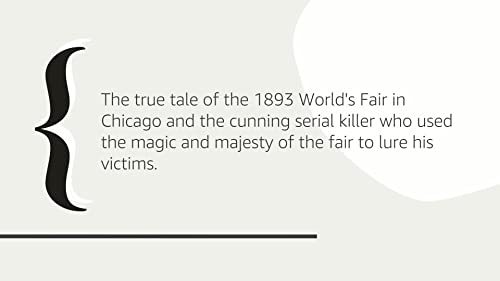
€4.58
The Devil In The White City Price comparison
The Devil In The White City Price History
The Devil In The White City Description
Discover *The Devil In The White City* – Your Gateway to Historical Intrigue
Uncover the gripping tale of *The Devil In The White City*, a riveting non-fiction narrative that intertwines the grandeur of the 1893 World’s Fair with the dark saga of America’s first documented serial killer. This compelling book, published by Vintage on February 10, 2004, spans 447 pages and takes readers on a thrilling journey through history, architecture, and crime.
Key Features and Their Benefits
- Expertly Written by Erik Larson: A master storyteller, Larson brings historical events to life. Readers will appreciate engaging prose that captivates attention and educates.
- In-depth History: Gain insight into the emotional and cultural context of the World’s Fair and how it represented America’s innovation and ambition during that era.
- Dual Narrative: Experience the juxtaposition of the fair’s architectural beauty against the terrifying backdrop of H.H. Holmes’ sinister activities, enhancing the reading experience.
- Quality Paperback Edition: The 447-page paperback is designed to last, with dimensions of 5.16 x 0.99 x 7.94 inches, making it a perfect fit for your bookshelf or travel bag.
- Lexile Measure of 1170L: Suitable for advanced readers, this book offers a challenging yet rewarding reading experience that enhances literacy and comprehension.
- ISBN Information: Easily locate this fascinating read with its ISBN-10: 0375725601 and ISBN-13: 978-0375725609.
Price Comparison Across Different Suppliers
When searching for *The Devil In The White City*, you’ll find varying prices across popular retailers. Our comparisons show that prices can fluctuate based on supplier and availability. Here’s a snapshot of what you can expect:
- Retailer A: $12.99
- Retailer B: $14.49
- Retailer C: $11.49
This competitive pricing allows you to choose the best deal for a remarkable story that is worth every penny!
Notable Trends from the 6-Month Price History
Recent trends in the price history chart indicate that *The Devil In The White City* has seen a slight decrease in average prices over the last six months. This trend suggests an opportune moment for potential readers to purchase this historical masterpiece at a more favorable rate, making it a smart choice for your literary collection.
Customer Reviews: Insights Into Reader Experiences
Customer reviews convey a rich tapestry of feedback regarding *The Devil In The White City*. Many readers praise Larson’s ability to weave together two distinct narratives seamlessly, describing it as “gripping” and “unputdownable.” The detailed exploration of the World’s Fair alongside the chilling nature of H.H. Holmes captivates both history buffs and true crime enthusiasts alike.
However, some readers noted the book’s occasionally dense details can slow the pacing, particularly for those unfamiliar with historical context. Overall, the majority of feedback reflects an appreciation for Larson’s meticulous research and storytelling prowess, confirming it remains a highly recommended read.
Engaging Unboxing and Review Videos
Enhance your purchase experience by checking out various unboxing and review videos on YouTube. These visual resources provide additional insights into the book’s quality and content, allowing you to see firsthand why *The Devil In The White City* is a must-read for anyone intrigued by historical narratives entwined with true crime.
Conclusion: Dive into a Captivating Story
*The Devil In The White City* is more than a book; it is an experience that transports readers to a fascinating time in America’s past. With its historical depth, intricate storytelling, and compelling characters, this book still holds its allure decades after its release.
Don’t miss your chance to own a piece of literary history. Compare prices now! Discover the best offers and start your journey into the haunting realities and awe-inspiring moments of the 1893 World’s Fair today!
The Devil In The White City Specification
Specification: The Devil In The White City
|
The Devil In The White City Reviews (7)
7 reviews for The Devil In The White City
Only logged in customers who have purchased this product may leave a review.









DM –
I just finished The Devil in the White City, a nonfiction book about the Chicago World’s Fair of 1893. Normally, I’m all about fiction, especially good ol’ crime novels, but this book really captivated me for a variety of reasons.
First, I somehow grew up without ever reading about the Columbian Exposition/World’s Fair in Chicago, and I now can’t imagine why I’d never heard of it. I guess the fact that the fair’s buildings and exhibits were torn (or burned) down contributes to people who’ve visited the city not knowing a huge (for that era) event took place there.
Second, the writing is top notch; it would have to be to keep my attention over what would normally seem like dull material to me. Often when I read, I’ll skip descriptive passages b/c I just want to know what’s going to happen. In this book, reading about aspects of the setting really enriched the story for me because the descriptions were so excellently done.
Next up is the fact that America’s first documented serial killer operated with total anonimity before and during the fair, luring young women (and some men, too) into his castle of horrors, robbing them, and then killing them with fairly passive means (gas, chloroform). His real interest seemed to be in dissecting his victims after they died. Really strange. He was a doctor and often sold the victim’s skeleton to medical schools and libraries.
I’ve never been “into” architecture, but this book was fascinating on the subject. As described, the “White City” was a breath taking sight, one I wish I could see with my own eyes. I imagine some of the sparkle on the fair’s many buildings resulted from the fact that most American architecture of the time prior had been utilitarian–get some wood, slap it together, and take shelter. The fair brought architects and engineers from all over the country together to build a remarkable city within a city. The Chicago artisans wanted to showcase their hometown to show it rivaled New York. The country and world were impressed with what they built. Interestingly, most of the buildings were fabricated from easily destructable materials that went up quickly because the whole affair got off to a late start.
It was at this fair that the Ferris Wheel made its debut. The exposition directors wanted to feature something as “awesome” as the Eiffel Tower, which had been the center point of the previous world’s fair. No one believed that Ferris could really pull off a machine of that size. The cars on the wheel weren’t what we think of today; they held 200 people and had windows/fencing (suicide prevention); thus, hundreds could ride the wheel at the same time.
The stories of how the fair came to be what it was and of the peculiar H.H. Holmes, the doctor who first charmed and then killed many women, are interwoven in a suspenseful way. It was one of those books I hated to see end. Another interesting sidelight for those of us who love travel and Disney: Walt’s father (grandfather?) attended the fair and raved about it often to the family. The author speculates it was this exposition that got Walt dreaming toward Disneyland and Disney World.
Leon –
Es una obra maestra tejida como un enorme tapiz.
IMPRESIONANTE.
Cliente de Amazon –
Muy bien libro y todo bien con el envío.
yeltrab, Janet –
Being from Chicago , was very interested in learning about this famous World Fair
Placeholder –
The novel is a historical account of the exposition in Chicago at the beginning of last centuries. The author contrasts the hero who tools for the exposition and also a villain who revels in killing people. On the whole, it is an interesting read. It was delightful tome as I am a civil engineer who can appreciate the problems faced in construction
Fred –
This is an exceedingly well written and engrossing account of two dramas, running parallel to each other in time and place and in alternating chapters of the book, depicting the creation and realization of the Chicago Colombian Exposition of 1893, with all its artistic, political, technical, and financial challenges, and the activities of a serial killer operating on its borders.
Bruce Kendall –
Erik Larson does a bang-up job of conveying what life must have been like in the “Second City” as the 19th century drew to its fitful conclusion. Bristling at the constant reminder of New York City’s superiority in so many areas, Chicago’s city fathers rallied the troops and went all out in proving to New Yorkers, to the nation and to the world that Chicago was equal to the great challenge of mounting a World Exposition of truly monumental stature. Larson’s descriptions of the Herculean effort put forth by numerous architects, builders, politicians, etc. lead the reader to a true appreciation of these “can do,” spirited individuals.
Yet beneath the teeming activity and a short distance away from the gleaming white Pleasure Palaces of the Fair, there stood a building of a different sort entirely, inhabited by one of the most vicious, truly evil creatures the young nation ever produced. Larson does an adequate, but not great job of telling the darker story surrounding H H Holmes, the mesmeric Svengali whose brilliant blue eyes and engaging charm seduced at least a score (one estimate was up to 200, which the author disputes) unfortunate women. Unlike Jack the Ripper, to whom he was later likened, he didn’t limit himself to female victims. Business partners who had outworn their usefulness and several children were amongst his prey, as well. He just had a penchant for murder.
The sections on the construction of the Columbia Exposition are filled with fascinating anecdotes, ranging from the origins of the sobriquet “windy city (derisively coined by Charles Anderson Dana, Editor of The New York Sun)” to the dramatic entrance of Annie Oakley, barreling in on horseback and blazing away with her two six-shooters in Buffalo Bill Cody’s Western Show adjacent to the Fair Grounds. Larson also provides an interesting side story surrounding Patrick Predergast, a delusional political aspirant who turns assassin. He paints a compelling portrait of Fredrick Law Olmstead, American History’s premier landscape architect who took up the almost impossible task of designing and overseeing the Exposition’s parks and lagoons. The hero of the book, however, is Daniel Hudson Burnham, who was ultimately responsible for the lion’s share of the planning, construction and smooth running of the entire enterprise. He had a little over two years from the time Congress selected Chicago from a list of candidate cities that included Saint Louis and New York, to the day of the Expo’s official opening. That he got the job done within the alloted time is one of the great marvels in an age of marvels, especially given the myriad difficulties which he and his crew had to overcome.
The Holmes narractive appears a bit lackluster in comparison to the story of the Fair’s construction. Larson acknowledges the difficulty he faced in recreating Holmes’ vicious crimes via imaginary vignettes. He states in an afterword that he went back and read Capote’s IN COLD BLOOD for the technique in which Capote so brilliantly engaged in his imaginative reconstruction of events. The only problem with this approach is that Capote had access to and the confidence of the two killers that are at the center of IN COLD BLOOD. Larson had only newspaper accounts from the period as well as a very unreliable journal that Holmes wrote after he was tried and sentenced to death (he was hanged several months after the trial). It would appear that Larson goes a bit too far out of his way to avoid the lurid and sensationalitic aspects of Holmes’ killing spree. One has only to visit some of the numerous web sites devoted to Holmes to see that Larson is particularly reticent to discuss Holmes’ sexual deviance. This is understandable, as Larson wants to be taken seriously as an historian, yet the facts are out there (most of them well documented) so it wouldn’t have hurt to have included a bit more of the darker details. The book could also have used more illustrations. The Chicago Tribune, at the time the story first broke in 1894, included a detailed floor plan of the “Chamber of Horrors” Holmes built on the corner of Sixty-Third and Wallace in the Englewood section of Chicago. That illustration would have given the reader a better sense of the bizarre layout of the structure. More pictures of the Exposition would have also been helpful. Here again, there are several sites on the web devoted to the Columbia Exposition that have many pages of great photographs.
The books virtues far outweigh its shortcomings and I have no problem in recommending THE DEVIL IN THE WHITE CITY to anyone interested in US History, Chicago Architecture, or just a well told story.
BEK